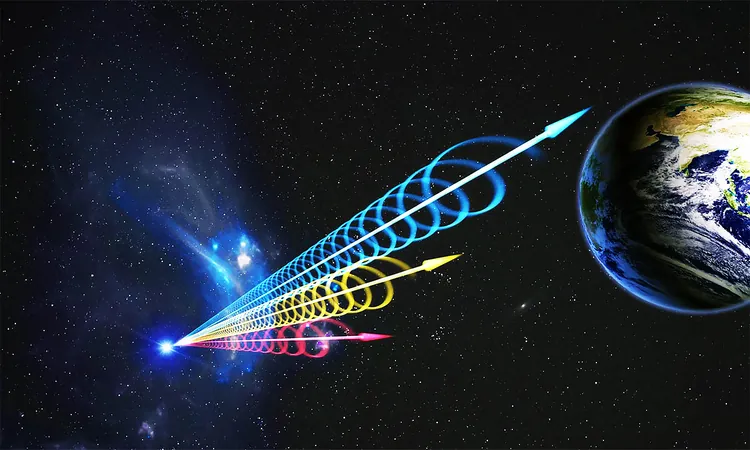
Unveiling Cosmic Mysteries: A Radio Signal From Deep Space Reaches Us After 8 Billion Years
2024-09-22
Author: Jia
Introduction
In a groundbreaking revelation, astronomers have detected a powerful burst of radio waves—known as FRB 20220610A—that traveled an astonishing 8 billion years to reach Earth. This remarkable discovery is one of the most distant and energetic radio signals ever recorded, stirring excitement within the scientific community.
What are Fast Radio Bursts (FRBs)?
Fast radio bursts (FRBs) are ultra-brief flashes of radio waves lasting merely milliseconds, yet their origins remain shrouded in mystery. These enigmatic signals provoke profound questions regarding their sources—who or what could be sending such potent energy bursts across the vast cosmos?
The Team Behind the Discovery
Dr. Stuart Ryder, a distinguished astronomer from Macquarie University, is part of a dedicated team of scientists committed to unraveling the intricacies surrounding these cosmic phenomena. Utilizing advanced technologies and collaborative research, they seek to decode the origins of these signals while opening new avenues for understanding the universe’s fundamental workings and its underlying forces.
The Nature of FRBs
First identified in 2007, FRBs have captivated the scientific world by exhibiting energy levels equivalent to what our Sun releases over 30 years—all in a split second. Researchers now believe that these cosmic events may be associated with magnetars, highly energetic remnants of supernova explosions.
Locating FRB 20220610A
To pinpoint FRB 20220610A’s origin, the astronomers utilized the Australian Square Kilometre Array Pathfinder (ASKAP). "We used ASKAP’s radio dishes to skillfully localize the burst’s source," Dr. Ryder explained. Their investigations led them to an older and more distant galaxy than previously identified for any other FRB, revealing important clues about the universe’s evolutionary timeline.
Understanding 'Missing Matter'
Interestingly, FRBs possess the potential to help scientists 'weigh' the universe. There exists a significant discrepancy between the observable matter in the cosmos and the theoretical predictions made by cosmologists. Approximately 95% of the universe comprises mysterious dark matter and dark energy, which elude direct detection. “More than half of the normal matter that should exist today is missing,” noted Professor Ryan Shannon, suggesting it could reside in obscure regions, such as the hot and diluted spaces between galaxies.
The Macquart Relation
Interestingly, the Macquart relation—established by the late Australian astronomer Jean-Pierre Macquart in 2020—allows scientists to leverage FRBs to measure this elusive intergalactic matter. Dr. Ryder points out that recent findings validate this relation even for bursts originating halfway across the observable universe.
Future of FRB Research
As it stands, nearly 50 FRBs have been traced to their sources, with ASKAP responsible for half of these discoveries. Professor Shannon believes that the next generation of radio telescopes currently under development could detect thousands more FRBs, leading to revolutionary advancements in cosmic mapping and cosmological studies. "FRBs are common and hold profound promise,” he stated. “They may assist us in constructing a comprehensive map of the universe's structure and in tackling significant questions in cosmology."
Conclusion
The ongoing hunt for answers surrounding the so-called “missing matter” remains crucial. Observable matter, such as stars and galaxies, constitutes only about 5% of the universe's total mass. This gap raises critical questions about cosmic formation and behavior. Studies employing sophisticated telescopes are already beginning to uncover hidden hydrogen clouds, indicating that much of the universe's matter could exist in undetectable or dispersed forms.
The exhilarating prospect of enhanced FRB research lies ahead as more advanced radio telescopes come online. Each new detection brings us closer to unraveling the mysteries encapsulated within these powerful cosmic flashes. As astronomers probe deeper, they hope to map the universe's intricate structures and answer fundamental inquiries about the forces and events shaping our cosmos.
Despite the substantial strides made in our understanding, FRBs continue to be among the universe’s most significant enigmas, highlighting just how much we have yet to learn about the vast expanse we inhabit.
Call to Action
Stay tuned as researchers delve further into this captivating phenomenon, opening doors to new insights that could redefine our comprehension of the universe!




 Brasil (PT)
Brasil (PT)
 Canada (EN)
Canada (EN)
 Chile (ES)
Chile (ES)
 Česko (CS)
Česko (CS)
 대한민국 (KO)
대한민국 (KO)
 España (ES)
España (ES)
 France (FR)
France (FR)
 Hong Kong (EN)
Hong Kong (EN)
 Italia (IT)
Italia (IT)
 日本 (JA)
日本 (JA)
 Magyarország (HU)
Magyarország (HU)
 Norge (NO)
Norge (NO)
 Polska (PL)
Polska (PL)
 Schweiz (DE)
Schweiz (DE)
 Singapore (EN)
Singapore (EN)
 Sverige (SV)
Sverige (SV)
 Suomi (FI)
Suomi (FI)
 Türkiye (TR)
Türkiye (TR)
 الإمارات العربية المتحدة (AR)
الإمارات العربية المتحدة (AR)